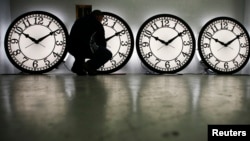Once again, most Americans will set their clocks forward by one hour this weekend, losing perhaps a bit of sleep but gaining more glorious sunlight in the evenings as the days warm into summer.
Where did this all come from, though?
How we came to move the clock forward in the spring, and then push it back in the fall, is a tale that spans over more than a century — one that's driven by two world wars, mass confusion at times and a human desire to bask in the sun for as long as possible.
There's been plenty of debate over the practice, but about 70 countries — about 40% of those across the globe — currently use what Americans call daylight saving time.
World wars
Germany began using daylight saving time during World War I with the thought that it would save energy. Other countries, including the United States, soon followed. During World War II, the U.S. once again instituted what was dubbed "war time" nationwide, this time year-round.
After World War II, a patchwork of timekeeping emerged across the United States, with some areas keeping daylight saving time and others ditching it.
To stem the confusion, in 1966 the U.S. Congress passed the Uniform Time Act, which says states can either implement daylight saving time or not, but it has to be statewide. The act also mandates the day that daylight saving time starts and ends across the country.
In the United States today, every state except Hawaii and Arizona observes daylight saving time. Around the world, Europe, much of Canada and part of Australia also implement it, while Russia and Asia don't.
Switching and grumbling
Changing the clocks twice a year leads to a lot of grumbling, and pushes to either use standard time all year, or stick to daylight saving time all year often crop up.
During the 1970s energy crisis, the U.S. started doing daylight saving time all year long, and Americans didn't like it.
With the sun not rising in the winter in some areas until around 9 a.m. or later, people were waking up in the dark, going to work in the dark and sending their children to school in the dark, said David Prerau, author of the book “Seize the Daylight: The Curious and Contentious Story of Daylight Saving Time.”
"It became very unpopular very quickly," he added.
He noted that using standard time all year would mean losing that extra hour of daylight for eight months in the evenings in the United States.








